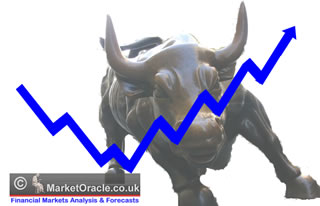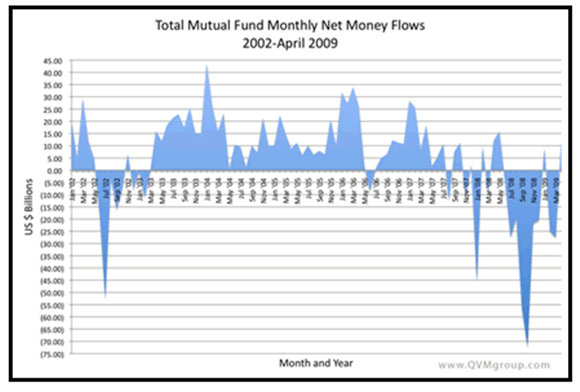This Stock Market is a Fool’s Paradise
Stock-Markets / Trader Psychology Jun 04, 2009 - 12:25 PM GMTBy: Q1_Publishing
 Bernard Baruch, one of the world’s most legendary speculators, said, “The main purpose of the stock market is to make fools of as many men as possible.”
Bernard Baruch, one of the world’s most legendary speculators, said, “The main purpose of the stock market is to make fools of as many men as possible.”
Right now, that’s exactly what’s going on. And I assure you, a lot of folks will be made into complete fools in the next year or so.
Chances are though, the folks who are going to look like fools are not who you think.
 A Fool and His Money
A Fool and His Money
The amount of bearishness from the market commentators is as strong as it ever was. The recent rally has only strengthened their resolve.
The thing is though, market meltdowns don’t happen when everyone expects them to. They happen when everyone is feeling safe. They happen when the market is overconfident. They happen when no one can find a reason not to buy. Right now, there is none of these.
The big money managers still don’t feel safe. The CBOE Volatility Index (a.k.a. the VIX or the Fear Index) is still at 31. The VIX is calculated by taking the implied volatility of option contracts on the S&P 500.
Simply put, the VIX is a measure of “portfolio insurance.”
When the VIX is high, the cost of insurance is high. It’s like buying catastrophe insurance for a house in Florida. The cost of insurance is high because of all the hurricanes. The perceived risks are high and that risk results in a higher cost.
When the VIX is low, it shows the cost of insurance is low. Right now, with the VIX at 31, it’s still relatively high. For instance, the VIX soared to a peak of 89 during the market extremes of 2008. The VIX, however, fell to less than 10 during the steady bull market between 2003 and 2007.
Basically, the cost of insurance is still high because the perceived risks are high. That perception still hasn’t changed.
Fools Rush In - at the Worst Possible Time
Most investors were absolutely crushed last year. There were very few safe havens outside of gold and U.S. Treasuries (And how many folks loaded up on both of these seemingly diametrically opposed assets?).
Almost everyone lost money – in most cases, they lost a lot of it. The effect of that is no one wants to take very much risk.
There are hundreds of thousands of investors thinking, “Sure, inflation is coming. And I’ll essentially be losing 6% a year in real terms. But hey, that’s a lot better than 45%.” But still, the safety and security of not having to fear of having to open the monthly brokerage account statement is a welcome relief to many.
Remember, confidence is slowly gained and easily destroyed. That’s why stocks go up slowly and fall quickly. Just like the old saying says, “Stocks go up stairs and down an elevator.”
Just take a look at how long it took for the markets to get its confidence back after the tech crash. After the steady collapse of the markets between 2000 and 2002, investors didn’t want much to do with stocks. They were very few bright spots in the economy and no one knew when or how the recession was going to end.
It took two years for the “true bottom” to form. There were plenty of starts and stops. The markets would jump and then fall right back down. Most investors simply threw in their collective towels during that period. Of course, looking back, it was a terrible time to sell out of the markets.
A Fool’s Hope: Buy High and Sell Higher
Now, look at what just happened. Between October 2007 and March 2009, the markets just continued to slide. Sometimes the fall was slow. Other times the down days were strung together five or six at a time.
Any sense of confidence in the markets was completely shaken out. The downturn was sharp and fast. Everything was going down.
Even the most experienced analysts and traders were a bit thrown off. Retail investors – a.k.a. average Joe investor – reached a near panic. They wanted out, wanted out completely, and they wanted out now.
Too see how badly they wanted out during this downturn compared to the tech crash, just look at the chart below which tracks mutual fund inflows and outflows.

Pretty big difference between the two, huh?
The data in the chart comes from the Investment Company Institute and it was compiled by analysts at the QVM Group. The chart shows how long it’s going to take to “recover” from the recent market downturn.
The VIX shows us the swashbuckling confidence and excessive risk-taking isn’t coming back for a long time. Fear is still high and the rules of investing when fear is high is a bit different.
A Juiced Market
This is a time when market movements accelerate everything.
Like most baseball players, the market is juiced. Everything is bigger and faster. Gains are bigger and come faster. Losses too are bigger and come faster. Volatility is still exceptionally high.
This is a key part of the long-run bottoming process. Remember, the market’s goal is to make a fool of as many people as possible.
That’s exactly what it’s doing right now.
The market starts going up for a while and sucks people in. Then it falls down again.
It moves up a little bit more and sucks more in. Then down.
It’s an unpredictable cycle that repeats again and again. It always ends the same though. It ends with one big rally that sucks everyone in.
And that right there is why I’m not bearish yet. We haven’t had the “big one” yet. Heck we might even be in it right now. But it’s not about to end now.
First, there are still $3.7 trillion on the sidelines. That’s a lot of money that hasn’t come back into the markets yet.
Also, the money from the $787 billion stimulus package has not been spent. According to Recovery.gov, less than 6% of it has been spent so far (insert joke here about how amazing it is to see how slow the government is at spending this money or about how big an “emergency” it really was).
Finally, the market is rising which helps create a positive “wealth effect.” With more than 70% of Americans owning equities directly or indirectly through mutual funds that has a big impact.
Think of a 55 year-old person who saw their $1 million portfolio fall to $500,000. It took six months to get used to the loss, but now it’s up to $600,000. Yes, I realize inflation will make that much less valuable in the long-term, but that $100,000 paper gain will impact whether he takes the wife out for dinner or not.
Those are all factors why I believe this rally could last a lot longer than most expect. Sure, there are plenty of problems lurking on the horizon. There are Alt-A mortgages and option-ARM’s which need reset. And interest rates will play a big role. And huge government deficits which have no near-term solution (well, at least one which is politically feasible anyways).
Coming Full Circle
That’s why I think this market is a “Fool’s Paradise.” And depending on which stage in the investor life-cycle you’re at will have a big impact on how well you do during this extended rally.
I remember when I just started investing. I did exceptionally well. I bought stocks as they were rising. I would sell after they climbed a bit. Some would go up 10% in a year. Others would go up 50% or more.
In hindsight, I had no idea what I was doing. But my strategy was simple. I bought stocks which were going up.
As I learned more, I became more confident in my skills of fundamental analysis and others. I reached the second stage. I knew something, but not enough. I loved how complicated it was and learned how to look at companies from a fundamental perspective.
I would wage a personal financial battle against the markets. I would find something I considered of value and buy it. And continue to buy it. There was no discipline or focus on risk. Of course, I was a bit overconfident. I was downright dangerous.
Here we are a few years later and I feel lucky to have reached the final stage. The point where you know one thing – don’t bet against the markets. It’s also the point where you ask, “How much can I lose,” before asking, “How much will I make?”
That’s why, despite all the bad news out there and the plenty more which is to come, there are plenty of opportunities here. One of our mantras has been to take what the market gives us and, even though we’ll have a few more down days like today, the market is giving us opportunities on the long side.
This market may be a “Fool’s Paradise,” but could also be dangerous. That’s why I’m long stocks and buying more, but also applying strategies to stay safe in this market.
The rally will end…eventually. But I think that’s quite a ways off. In fact, I’m more excited than ever for the summer. And in the next Prosperity Dispatch we’ll look at three areas which will pay off exceptionally well in the next few months.
Good investing,
Andrew Mickey
Chief Investment Strategist, Q1 Publishing
P.S. That’s not the case for agriculture though. The way things are shaping up, there could be a tremendous short-term opportunity in agriculture on top of the exceptional long-term prospects. More to come in the weekend edition of the Prosperity Dispatch.
Q1 Publishing is committed to providing investors with well-researched, level-headed, no-nonsense, analysis and investment advice that will allow you to secure enduring wealth and independence.
© 2009 Copyright Q1 Publishing - All Rights Reserved
Disclaimer: The above is a matter of opinion provided for general information purposes only and is not intended as investment advice. Information and analysis above are derived from sources and utilising methods believed to be reliable, but we cannot accept responsibility for any losses you may incur as a result of this analysis. Individuals should consult with their personal financial advisors.
Q1 Publishing Archive |
© 2005-2022 http://www.MarketOracle.co.uk - The Market Oracle is a FREE Daily Financial Markets Analysis & Forecasting online publication.



